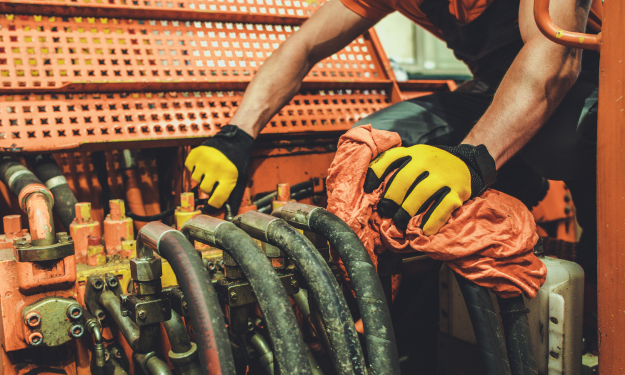Maintaining an excavator’s proper hydraulic fluid levels is crucial for optimal operation. Excavators rely on hydraulic fluid to power their moving parts, and keeping the fluid at the right level is essential, as failure to do so can lead to significant mechanical issues.
To add hydraulic fluid to an excavator, the operator must first locate the reservoir and make sure the machine is on level ground.
Before adding hydraulic fluid, it’s essential to consult the excavator’s manual to determine the recommended type and specifications of the fluid. This preliminary step helps avoid potential damage from using the wrong hydraulic fluid.
Furthermore, allowing the excavator to cool down if it has been in use is critical, as hot fluid can expand and provide an inaccurate reading.
A well-rounded introduction to this maintenance task emphasizes the importance of safety, correct fluid selection, and adherence to the manufacturer’s guidelines to ensure the longevity and efficiency of the excavator’s hydraulic system.
Importance Of Hydraulic Fluid
Excavators rely heavily on their hydraulic fluid, which plays a crucial role in ensuring the machine’s smooth operation. When purchasing a used excavator, it is expected to top up the fluid.
This fluid provides the necessary force to move the boom, arm, and bucket. Let’s take a closer look at the critical role of hydraulic fluid in the excavation process.
Proper Lubrication And Cooling
Hydraulic fluid serves a crucial role in excavators beyond power transfer. It prevents the moving parts of the excavator from grinding against each other, which reduces wear and tear.
Additionally, this fluid helps cool down the machine’s components, resulting in better performance. A well-maintained excavator is a happy excavator!
Ensuring Optimal Performance
- Maintains hydraulic pressure: Keeps the machine working at peak efficiency.
- Protects against rust: Shields internal components from corrosion.
- Minimizes contamination: Clean fluid means fewer blockages and breakdowns.
Remember to check the fluid regularly. It could mean the difference between a productive day and costly downtime.
Identifying The Hydraulic Fluid Type

Identifying the correct type of hydraulic fluid for your excavator is crucial. It ensures the smooth operation of your machinery. Various types of hydraulic fluid exist, each with specific properties and uses.
Your excavator needs the correct fluid to ensure its hydraulic system remains efficient and long-lasting.
Consulting The Excavator Manual
The first step in identifying the correct hydraulic fluid is consulting the excavator manual. The manual is your go-to resource. It provides detailed information on the specific type of fluid the manufacturer recommends.
Manuals often list the preferred fluid brand, viscosity, and any acceptable substitutes. Always follow the manual’s guidelines to avoid potential damage to the hydraulic system.
Checking Fluid Specifications
If the manual is not available, check the fluid specifications. Look for labels or markings near the hydraulic fluid reservoir. They often indicate the required fluid type. If information is not visible, consult the dealer or an expert mechanic.
They can guide you in selecting the suitable fluid for your excavator based on its model and operating conditions.
Make sure to note these important points:
- Viscosity: Match the thickness of the fluid to your operating environment.
- Additives: Some fluids have additives for better performance.
- Compatibility: Ensure the new fluid is compatible with the current one.
Always handle hydraulic fluids safely. Wear protective gear. Clean any spills promptly to prevent environmental damage and slipping hazards.
Gathering The Required Tools
Before adding hydraulic fluid to an excavator, having the right tools in hand is crucial. These tools make the process smooth, preventing spills and contamination. The guide below outlines the necessary items for the job and how to use them efficiently.
Protective Gloves
Always prioritize safety when handling hydraulic fluid. Protective gloves shield the skin from irritation and allergic reactions. Nitrile or PVC gloves offer the best protection and durability during this task.
Funnel Or Pump
A funnel or suitable pump is essential for adding hydraulic fluid without spilling. Choose a clean, dedicated funnel or a hydraulic fluid pump to ensure a safe and clean fluid transfer into the reservoir.
Clean Rag
Always keep a clean rag within reach. It’s used for wiping off any excess fluid that might spill and for cleaning the area around the fill cap. This prevents dirt from entering the hydraulic system, which could cause damage to the excavator.
| Tool | Function | Importance |
|---|---|---|
| Protective Gloves | Skin Protection | Prevents irritation |
| Funnel or Pump | Transfer Fluid | Prevents spills |
| Clean Rag | Clean and Wipe | Keeps the system clean |
- After use, clean tools thoroughly to prevent fluid contamination.
- Store tools in a clean, dry place to maintain their condition.
- Inspect tools regularly for signs of wear or damage.
Locating The Hydraulic Fluid Reservoir

Maintaining your excavator is crucial for its performance. A vital part of this maintenance is ensuring that the hydraulic fluid levels are correct.
The first step is to locate the hydraulic fluid reservoir. This task might feel daunting, but with the correct information, it’s pretty straightforward. Below are steps to find this essential component.
Checking The Excavator Structure
Before you start, take a moment to inspect the excavator visually. The hydraulic fluid reservoir is usually located near the engine.
It’s a large tank with a fill cap on top. Look for labels or signs that indicate its exact position. Keep safety in mind while you search to avoid any potential hazards.
Referring To The Manual
The excavator’s manual is your best friend in this situation. Manuals typically have diagrams showing the location of the hydraulic fluid reservoir.
If you’ve lost your manual, you can often find a digital copy online by searching for your excavator’s model number.
Following these simple steps, you can locate the hydraulic fluid reservoir and keep your excavator in top working condition.
Checking The Fluid Level
Maintaining your excavator’s right hydraulic fluid level is crucial for its performance. Regular checks can save both time and money. Let’s go through the essential steps to ensure your excavator operates smoothly.
Removing The Fill Cap
First, locate the fill cap on your excavator to check the hydraulic fluid level. This cap covers the fluid reservoir. Most machines have this cap at the hydraulic tank’s side or top.
Before you remove the cap, make sure to clean around the area to prevent dirt and debris from entering the system. Use a clean rag to wipe any grime.
Gently twist the cap to open it. If the cap is tight, you might need a tool to help twist it off. Just be careful not to damage the cap or reservoir neck.
Using A Dipstick Or Sight Glass
Once the fill cap is off, you will either use a dipstick or sight glass to check the fluid level. Dipsticks are metal rods that measure the fluid’s depth in the tank. Wipe it clean, insert it back in, and pull it out to see the fluid mark.
The reservoir usually has markings for the correct level. If you have a sight glass, it’s even simpler.
Look for a clear view of the fluid level against marked lines on the glass.
| Step | Action | Tip |
|---|---|---|
| 1 | Locate fill cap | Always clean before opening |
| 2 | Remove fill cap | Use tools if needed |
| 3 | Use a dipstick or sight glass | Check against markings |
If the level is low, it’s time to add hydraulic fluid. Be sure to use the correct type of fluid for your excavator.
Maintaining your hydraulic fluid can prevent potential damage and keep your machine running at peak performance.
Draining Old Hydraulic Fluid (if Necessary)
Maintaining an excavator includes changing its hydraulic fluid regularly. When adding fresh hydraulic fluid, you may need to drain the old one first. Draining old hydraulic fluid prevents contamination and keeps your machine running smoothly.
Let’s guide you through this critical process.
Identifying The Drain Plug
Finding the drain plug is the first step. This plug is at your excavator’s lowest hydraulic fluid point. Its location varies by model, so check your manual. Look for a bolt or cap at the hydraulic tank’s base.
- Steps to identify the drain plug: Examine your user manual for specific instructions.
- Spot the plug at the tank’s bottom, often marked.
- Ensure machines are off and cool before touching them.
Collecting The Fluid In A Container
Drain the fluid safely into a suitable container. This prevents spills and environmental harm. Below are steps to collect the old hydraulic fluid cleanly and securely.
- Guidelines for fluid collection: Choose a container that can hold the total fluid amount.
- Place it directly under the drain plug to avoid spills.
- Unscrew the plug carefully to manage the fluid flow.
Remember to wear gloves and safety glasses during this process. Old fluid can be messy and potentially harmful.
Adding New Hydraulic Fluid
Running an excavator with low hydraulic fluid can cause significant damage. Refilling the hydraulic system is a crucial maintenance task.
Safety is paramount, so always wear gloves and eye protection. Make sure the excavator is on level ground. Begin by locating the hydraulic fluid reservoir and removing its cap.
Using A Funnel Or Pump
Choose a clean funnel or a hydraulic pump system for this task. Using the right tools prevents contamination and spillage.
- Inspect the funnel or pump for cleanliness.
- Attach it securely to the reservoir’s opening.
- Check the excavator’s manual for the correct type of hydraulic fluid.
Pouring slowly and steadily
Pouring Slowly And Steadily
Slow and careful pouring reduces the risk of air bubbles. Air in the hydraulic system can lead to erratic operation.
- Begin pouring the hydraulic fluid into the funnel or pump.
- Fill to the recommended level, but do not overfill.
- Monitor the fluid level indicator as you pour.
After adding the new fluid:
- Inspect the system for leaks.
- Replace the cap on the reservoir and clean up any spills.
- Run the excavator through a few cycles to distribute the fluid.
- Recheck the level and top off if needed.
Verifying The Fluid Level
Maintaining the right level of hydraulic fluid is key to keeping your excavator running smoothly. It’s like checking the water level in your fish tank; too low, and your fish are in trouble. Not enough fluid may lead to damage or reduced efficiency.
Checking With Dipstick Or Sight Glass
Finding out if you need more fluid is simple. Start by locating either the dipstick or sight glass on your excavator. This is your window into the world of hydraulic fluid levels.
- Clean around the dipstick to avoid contamination.
- Remove the dipstick and wipe it with a rag.
- Insert it back in, then pull it out again to check.
For the sight glass, just give it a look. You want a clear view to ensure accuracy. The correct fluid level sits between the minimum and maximum markers.
Adding More Fluid If Needed
When levels are low, it’s time for a top-up. Use the type of hydraulic fluid recommended for your excavator. This is important for keeping the machine healthy.
- Locate the hydraulic fluid reservoir and remove the cap.
- Add fluid slowly, checking the level as you go.
- Do not overfill; stick to the max marker.
Once done, replace the cap securely. You’re now set with the right fluid level. Your excavator is ready to dig, lift, and load again. Remember, proper levels mean a happy, healthy machine.
Cleaning Up And Proper Disposal

Maintenance of an excavator includes the responsible addition of hydraulic fluid. But what happens after? Knowing how to clean up spills and dispose of hydraulic fluid properly is crucial. It safeguards the environment and complies with legal requirements. Let’s walk through the cleanup and disposal steps.
Wiping Spills With Clean Rag
Spills happen, but quick action is key. Grab a clean rag to wipe up any hydraulic fluid. Use a non-abrasive cloth to avoid scratching the excavator’s surface.
- Act fast to minimize spill spread.
- Soak up the fluid with a clean, absorbent rag.
- Dispose of the used rags responsibly.
Following Local Regulations For Disposal
Disposal of hydraulic fluid requires following local regulations. Contact local waste disposal agencies for guidelines. Never pour hydraulic fluid down the drains or onto the ground.
- Reach out to local environmental agencies.
- Obtain proper disposal containers or facilities.
- Transport the used fluid according to guidelines.
All actions should ensure environmental protection. It helps avoid contamination and legal issues.
Frequently Asked Questions
When Should Hydraulic Fluid Be Replaced?
Hydraulic fluid should be replaced according to the manufacturer’s guidelines, or when you notice changes in the system’s performance. This often pertains to degraded fluid quality or if contamination is present.
How Can I Check The Hydraulic Fluid Level?
Check the hydraulic fluid level by locating the fluid level gauge on the excavator. It’s typically a sight glass or dipstick. Ensure the excavator is on level ground before checking to get an accurate reading.
What Type Of Hydraulic Fluid Is Best For Excavators?
The best hydraulic fluid for an excavator is specified by the manufacturer. Use the grade and type recommended in the owner’s manual to ensure optimal performance and to avoid potential damage.
Can I Mix Different Brands Of Hydraulic Fluid?
Mixing different brands of hydraulic fluid is not recommended. This can lead to reduced performance, system contamination, and potential damage due to incompatible additives or differing viscosities.
Conclusion
Maintaining your excavator’s hydraulic system is crucial for optimal performance. Following the steps outlined ensures a safe and effective fluid top-up.
Remember to consult your owner’s manual for specifics and always wear protective gear. Regular checks can save time and costly repairs, keeping your machinery in prime working condition.
Stay proactive with machine maintenance for seamless operation.

